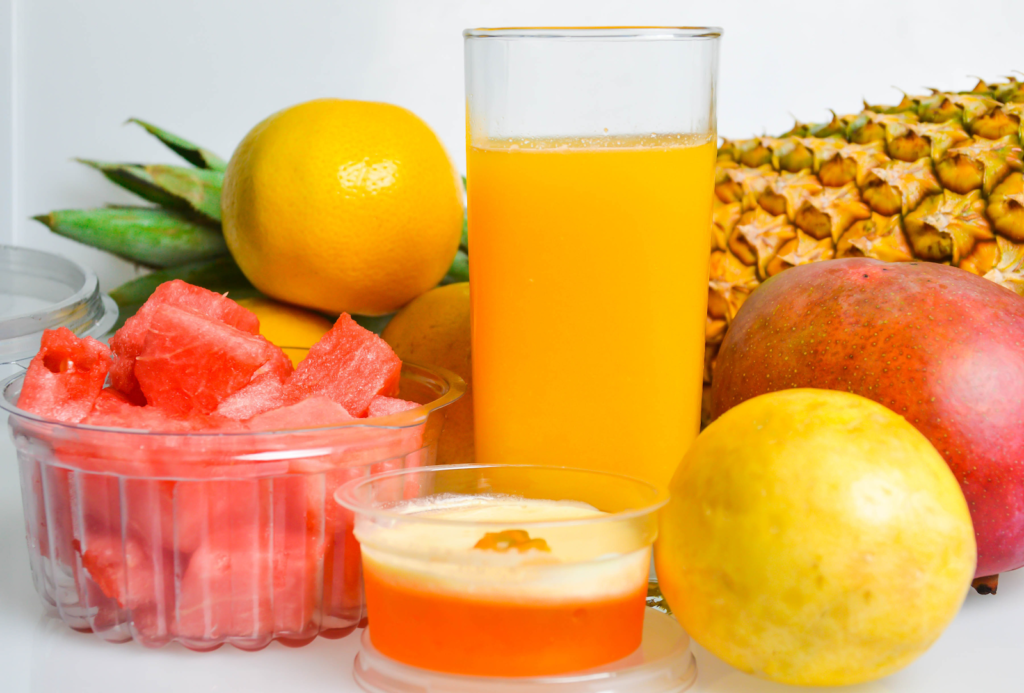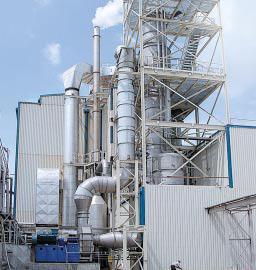Fruit juices are beverages made from the extraction of liquid contained in fruits. The most common fruit juices consumed in the United States are made from oranges, apples, and grapes.
The fruit juice industry began in 1869 when Concord grapes were first juiced, filtered, and bottled as a beverage. Fruit juicing was originally a salvage operation for overripe or poorly conditioned fruit deemed not suitable for canning. During the Great Depression, fruit and vegetable canning increased resulting in an increase in fruit juicing. At the same time, preservation advancements further contributed to growth in the industry. Today, approximately 2 billion gallons of fruit juice are consumed annually in the United States, with orange juice contributing to approximately 60% of juice consumption.

Fruit is processed to form two types of juices, not from concentrate (NFC) juice and reconstituted juice. The following sections describe unit operations and relevant equipment used to prepare, produce, and preserve NFC and reconstituted juices.
Ingredient Preparation
In most fruit juice markets, products must be 100% juice and contain no additives. Therefore, fruit is the only ingredient prepared for fruit juice production. Fruit preparation methods differ for soft fruit, such as apples and grapes, and citrus fruit.
For all fruit types, preparation begins with washing and inspection to remove particulate matter and microbial contamination or rot. Fruit is first transported from storage into the process on roller conveyors. The fruit is then washed and passed over roller brushes. This step is followed by an additional rinse and drying before inspection. During inspection, the fruit is conveyed and passes graders who remove fruit with visible damage or rot. This step is essential to prevent exposure of tainted or toxic juices to the public. After washing and inspection, soft and citrus fruits are processed differently to extract liquid juices
Soft Fruit Milling
Soft fruit must be milled before the fruit is extracted for juice. The hammer mill is the most common mill used in soft fruit juice processing. In a hammer mill, fixed or free hammers repeatedly pound the soft fruit forcing smaller fruit particles, or mash, through a screen within the hammer mill. Fixed knife mills are also commonly used in industry. These mills push soft fruit against fixed knives, shredding the fruit. Smaller holes underneath the knives allow the resulting fruit mash to fall onto a conveyor for further processing. In both milling operations, modifications may be made to process stone fruit, such as peaches or cherries, by removing stone fruit pits during the process. After milling, the resulting mash is ready for further preparation.
Soft Fruit Pressing
Soft fruit mash must be pressed to fully prepare a fruit juice for production. The screw press is the most common press used in North American soft fruit juice processing. In a screw press, mash is added from a hopper into the top of a rotating screw. As the mash moves down the press, it becomes compressed and juice flows down the conical walls. Hydraulic presses are also commonly used to crush fruit mash and prepare fruit juice. For high-volume juice processing, automated hydraulic presses that operate on a rotating cylinder are used to repeatedly press batches of fruit mash. Additionally, press aids may be added to the mash to increase yield in the pressing operation. Press aids, typically fibrous materials like wood chips, provide channels for juice to drain during the operation. Some operations also treat soft fruit with enzymes prior to pressing. These enzymes break down fruit cell structures and maximize juice yield. After pressing, the resulting soft fruit juice is ready for production.
Citrus Extraction
Citrus fruit, in turn, is shielded by a peel, which prevents simple preparation of citrus fruit juice by milling and pressing. Complicated extracting machines are used to prepare citrus fruit juice. One type of extractor inserts metal tubes in the top and bottom of citrus fruit. The extractor then compresses the fruit to squeeze out juice through the metal tubes. Juice passes through perforations within the tubes to be used in production. Another type of extractor, shown below, cuts citrus fruit in half with a stationary knife. Serrated reamers then exert pressure on the pulp side of citrus fruit halves expressing juice. Additionally, pulp is separated from the peel and juice. The pulp can be washed and added back further into production if desired. After extraction, citrus juice is ready for production.
Production
Fruit juice production consists of concentration, essence recovery, and mixing. These production steps apply to reconstituted juice products, whereas Not From Concentrate (NFC) juice products bypass production steps and are simply preserved. The following sections describe these production steps for reconstituted juice products and preservation steps for all juices.
Concentration
In the concentration step, water is removed from juice to make a highly concentrated mixture. For juice processes that operate at multiple facilities, the concentrated form is ideal for transfer between the facilities. Falling film evaporators, shown below, and centrifugal evaporators are commonly used to concentrate juice. These evaporators are ideal as they expose juice to a high temperature for a short time. This minimizes thermal degradation that could affect the taste of the final juice product. After concentration, the resulting products from the evaporators are a water vapor mixture and a concentrated juice mixture used for further processing.

Essence Recovery
Essence recovery consists of unit operations to recover essence oil or water-phase essence from fruit juice. These chemicals contain many of the desirable flavors and aromas that fruit provides. For soft fruit processing, essence recovery typically occurs before concentration. Stripping columns are used to strip water from the soft fruit juice following preparation steps. The stripped water contains essence chemicals that are further separated in distillation columns, shown below. The resulting product is a concentrated, water-based essence solution, which will be used in the mixing step. For citrus fruit processing, essence recovery occurs after concentration. During citrus juice concentration, much of the desirable essence is evaporated with the water vapor. Common recovery units include distillation columns and condensers. The resulting substances recovered are water-phase essence and essence oil. These flavorful mixtures will be included in the next step of production. The process mirrors spice extraction. For more details on essential oils go to the spice and extract module.
Mixing
The resulting concentrate and essence are typically used in the final step of fruit juice production, mixing. Additionally, these intermediates can also be sold to soft drink manufacturers to be used as the characteristic flavoring in fruit-flavored soft drinks, such as orange soda.

Mixing concludes the production process by combining concentrated juice and essence to achieve the desired juice blend. In the mixing operation, fractions of several concentrated juice batches are transported from bulk storage tanks to liquid-liquid blending units. The concentrated juice batches are blended to target the desired sugar to acid ratio as well as color. This ensures a uniform product is always formed. Additionally, essence solutions and oils are added to recover flavor lost during concentration. After mixing, a uniform fruit juice product is ready for preservation and testing for quality assurance.
Preservation Methods
Preservation methods are practiced to prevent spoilage and any resulting harm to fruit juice consumers. Preservation methods vary for NFC and reconstituted juice processes.
To preserve NFC juices, pasteurization is used after juice preparation. During pasteurization, the juice is heated to temperatures that will denature proteins in microbial life that may be present in the juice. The juice is then quickly cooled to prevent any thermal degradation that may affect the fruit juice flavor. The heating and cooling operations must be done rapidly to prevent microbial growth and preserve flavor. In industry, stainless steel plate and frame heat exchangers, shown below, are commonly used for rapid heating and cooling operations. After pasteurization, NFC juices are further preserved through the packaging operation.
Furthermore, reconstituted juices are preserved after packaging by freezing operations. As reconstituted juices do not typically undergo pasteurization, freezing preserves the product from contamination as it hinders microbial and chemical activity. Freezing is used in the storage and transportation of packaged fruit juice before distribution to vendors.
Packaging
Packaging is an additional form of preservation and is practiced in NFC and reconstituted juice production. In high-volume production, automated filling lines may be used to package juice into bottles, cans, boxes, or cartons. Filling operations consist of highly specialized equipment and vary in design and level of automation for each manufacturer. However, the same general process is followed. Empty containers are fed to the operation using conveyors. The container is filled then closed and conveyed to secondary packaging, such as boxes. Packaging prevents juice exposure to outside contaminants that may alter the final product composition or flavor. Additionally, some processes rapidly heat juices prior to filling to sterilize the packaging internally.
Quality Control
Quality control methods are practiced in fruit juice production to prevent spoilage and ensure highly consistent products for the consumer. Consistent juice is highly dependent on a balance of sugar content and acidity. First, government inspectors must certify that incoming fruit may be used for processing by meeting minimum standards of sugar content and acidity. To create products with little variation in sugar and acid, juice processors will blend fruit grown in different climates. Warmer climate fruits tend to have higher sugar content, whereas cooler climate fruits are generally more acidic. Juice processors ensure the desired balance is met by testing the raw material fruit and final product for both parameters. Sugar content is measured by brix refractometers, shown below, and acidity by titration methods. Aside from sugar content and acidity, fruit juice products are also tested for color and taste after production.

Furthermore, fruit juice quality is assured by inside and outside inspection of production processes. As previously mentioned, fruit graders visually inspect fruit during preparation to remove fruit containing rot. This prevents contamination of fruit juice products that can harm the consumer. Additionally, fruit juice processors voluntarily submit their products for outside audits to confirm the products are unadulterated.
After passing quality control methods, final fruit juice products are ready to be delivered to stores, restaurants, and more for consumer enjoyment.
Acknowledgments
- Essex Scientific Laboratory Supplies
- GEA Process Engineering Inc
- Wikimedia Commons, by Ubcule, A glass of Barr orangeade (also known as orange soda) and its can
- Wikimedia Commons, Various fruits mixed into a glass of pineapple juice
References
- Ashurst, Phillip R. “Fruit Juices.” Kirk-Othmer Encyclopedia of Chemical Technology (2007): Wiley Online Library. Web.
- Bates, R. P., P. G. Crandall, and J. R. Morris. Principles and Practices of Small- and Medium-scale Fruit Juice Processing. Rome: FAO, 2001. Print.
- Farkas, Daniel F. “Food Processing.” Kirk-Othmer Encyclopedia of Chemical Technology (2015): Wiley Online Library. Web.
- Morrow, R. Steve, and Christine M. Quinn. “Carbonated Beverages.” Kirk-Othmer Encyclopedia of Chemical Technology (2007): Wiley Online Library. Web.
- “Oranges and Apples Are America’s Top Fruit Choices.” USDA ERS – Chart Detail. N.p., 2016. Web. 25 Aug. 2017.
Developers
- Nathan Hoffman
- Austin Potter
